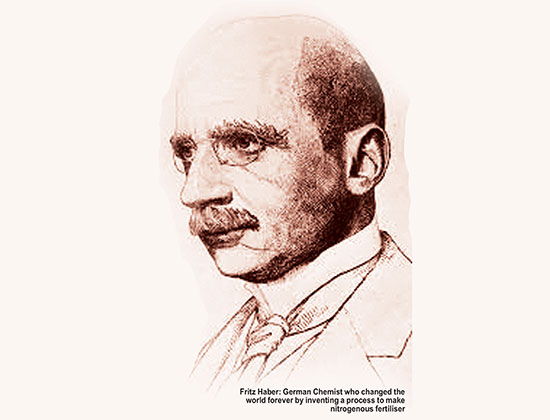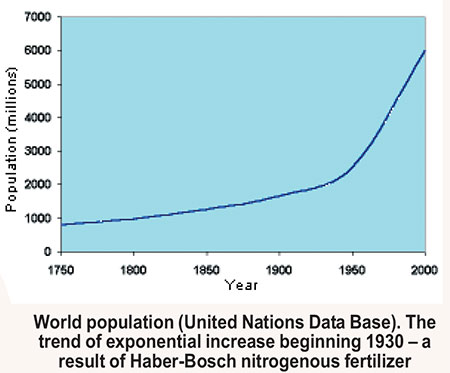Perpetuating myths about fertilisers
Posted on May 25th, 2021
By Prof.Kirthi Tennakone, National Institute of Fundamental Studies
(ktenna@yahoo.co.uk )

Discussions on chemical fertilisers aroused by the belief they are harmful and degrade the environment worry farmers. The crux of the confusion appears to be that many have forgotten the science learnt in the eighth grade.
At school every kid learns that plants grow when green leaves assimilate carbon as carbon dioxide from the atmosphere and roots extract essential chemical elements in the form of compounds dissolved in water from soil. Both these processes utilise energy derived from sunlight. Plants synthesise; carbohydrates, proteins and fats – the crucial components of foods eaten by humans and animals.
Chemical elements the plants require in largest quantities derived from soil are nitrogen, phosphorus and potassium; denoted N, P and K. Plant growth and metabolism also utilise substantial quantities of sulfur (S), magnesium (Mg) and calcium (Ca). The elements N, P, K, S, Mg and Ca which plants obtain from the soil are termed macronutrients. Plants also need much smaller quantities of several other elements; notably; zinc (Zn), iron (Fe), manganese (Mn), copper (Cu) and boron (B); termed micronutrients.
What is a fertiliser?
Fertilisers are substances containing plant macro and micro nutrients in chemical constitutional forms that could be absorbed by roots.
In the sense of the above dentition; carbon is not a fertiliser, because plants harvest carbon from the atmosphere.
Being suppliers of macro and micro nutrients to plants; all fertilisers are intrinsically chemical in nature and non-chemical fertilisers does not exist. The plants synthesise food for everybody, utilising air, water and inorganic macro and micro nutrients, via a series of chemical reactions.
Chemical Fertilisers
Inorganic chemical fertilisers contain concentrated quantities of macro and micro plant nutrients, generally in optimally available chemical constitutions. Nitrogen in form of nitrates, ammonium salts or urea; phosphorus as phosphates of calcium, potassium or ammonium; potassium as sulfates, chlorides or phosphates and micronutrients as inorganic salts of respective elements. These are stable sources of essential elements, mixed in appropriate proportions. Unless excessively applied, chemical fertilisers are not toxic to plants or pose no serious threats to environment or human health. Above-mentioned chemical fertilisers in their exact and ideal compositions and applied optimally are economical, healthy and least damaging to the environment compared to alternatives. Environmental damages caused by fertiliser manufacturing processes has been minimised, but cannot be avoided completely.
Problems of Commercial
Chemical Fertilisers
Some brands of commercial chemical fertilisers may be contaminated toxic heavy metals such as cadmium, arsenic and lead, as a result of their occurrence in the original precursor minerals or other substances used in the manufacturing process. Their presence can be easily detected by chemical analysis. The problem of heavy metal contamination pertains mostly to phosphate fertilizers; because some rock phosphates deposits used to produce more water-soluble fertilisers, naturally contain hazardous amounts of heavy metals. Arsenic could also be a contaminant of sulfuric acid used in beneficiation of rock phosphate (apatite) to increase the water solubility.
The other hurdles of chemical fertilisers arise as result of their excessive application- beyond amounts plants require. Excess nitrogenous and phosphate fertilisers pollute water and soil creating environmental and health issues.
Use of uncontaminated brands and educating farmers, resolve both these problems.
Fertiliser Manufacture
Until early 1930s world food production has been largely limited by availability of nitrogenous fertilisers – starvation, malnutrition and famines quite common. Nitrogenous manures used were plant and animal waste products often converted to compost and rarely naturally occurring nitrates.
Although nitrogen is abundant in the atmosphere; its chemical inertness prevents easy conversion into nitrates or ammonia. A process which does it (conversion to nitrates) once in a way is lightning – obviously insufficient to manage agriculture. Bacteria associated with leguminous plants also fix nitrogen, but insufficient to meet the demand.
The first person to fix nitrogen artificially was the British chemist Humphrey Davy. In 1807, he found small quantities of ammonia could be produced by electrolysis of nitrogen purged alkaline water.
A major breakthrough by German Chemist Fritz Haber in 1807, changed the world forever. He found an efficient method of combining gaseous nitrogen and hydrogen to form ammonia activated by a catalyst. The process further improved by Carl Bosch, widely commercialised beginning 1930, provided the ample supplies of nitrogenous fertiliser, boosting agriculture and food production – greatly reducing premature deaths due to starvation and malnutrition. Demographic data clearly indicate, the trend of population expansion initiated by Haber-Bosch process (see figure above). World population limited by supply of food escalated exponentially; increasing from approximately 2 billion in 1930 to 7.7 billion today. The world can marginally sustain only about half of the present population without nitrogenous fertilisers synthesised via Haber-Bosch process. If this process was not invented; the glamorous comforts we have today and many of us would not be here.
It can be argued, the unprecedentedly aggressive COVID-19 pandemic is a consequence of the Haber –Bosch nitrogenous fertiliser production, because high population density happens to the main cause of virus propagation. Again, nitrogenous fertiliser based agriculture may irreversibly impair the environment. Can we curtail fertiliser production by Haber-Bosch process because of above reasons? Yes, but half of world’s population will faces the risk starvation and conflicts originating as result of food shortage would kill many more!

Green Revolution and Fertilisers
Haber-Bosch process opened the way for the green revolution the next step in the ladder of agricultural development. The main achievement of the green revolution initiated 1960s has been breeding high yielding varieties of crops. Cultivation of such crops using chemical fertilisers and agrochemicals, uplifted food production particularly in developing countries. These crops were bred and made to evolve under conditions of a good supply of plant nutrients applied as chemical fertilisers and their continuation require same treatment. They would not perform satisfactorily, when fed with inferior fertilisers.
Organic Fertilisers and
Bio – fertilisers
Organic fertilisers sometimes erroneously referred to as carbon fertilisers use plant or animal derived materials as sources containing nutrients. In highlighting the term ‘carbon fertiliser’ the ignorant tend to believe that plants could consume carbon in soil and grow! Organic manures contain macro and micro plant nutrients, converted to inorganic forms by denaturing and bacterial decomposition. They have the advantage as soil conditioners and retainer of nutrients, owing to presence carbonaceous substances. Microorganisms present sometimes establish symbiotic relationship with plants. However, the concentration of nutrients per unit weight of organic fertilisers turns out to be orders of magnitude smaller than that of commercial chemical fertilisers. Consequently, their storage, packaging and transport are more cumbersome and costly. If based entirely of plant or animal derived materials; organic fertilisers remain largely uncontaminated with toxic heavy metals. Nevertheless, one need to be cautious in converting domestic and city refuse to compost. In addition to vegetable and animal derived waste; garbage invariably contains metallic objects, plastics, discarded batteries and pieces of electronic components. All these non-biological things in garbage contain heavy metals and other toxic substances. Processing of organic fertiliser also degrade the environment.
Bio-fertilisers means preparations containing microbes, claimed to promote plant growth when introduced to soil. Microbes are said to establish symbiotic relationship with the plant root system, enhancing nutrient absorption and may also fix nitrogen. An open question is whether an inoculum of microbes will proliferate and survive sufficiently long in every soil associating with different crops. The literature on the subject inclines more towards advertising products rather than analysis of experiments and field trials to determine the efficacy and reproducibility. Evidence doesn’t exist to the effect that bio-fertilisers could replace conventional chemical fertilisers and deliver yields adequate to feed the world population.
Another much advertised fashion is organic farming. The concept of the organic farming imply use of only naturally occurring materials as fertilisers and agrochemicals. Although the yields of organic farming rarely compare with conventional products they are claimed to be healthier and attract the affluent. Avoiding synthetic pesticides is definitely a merit. However, the claim that organic fruits and vegetables contain no toxic heavy metals couldn’t be always true. Organic farming permits use of rocks as fertiliser components and therefore apatite as a source of phosphorous. Some apatite ores are contaminated with heavy metals, including radioactive elements.
Hydroponics
Hydroponics refers to growing plants without soil in water enriched with macro and micro plant nutrients and illuminated by sunlight or electric lights. The method minimise fertiliser wastage almost completely avoiding their seeping to soil and affords using purest chemical fertilisers, entirely free of toxic contaminants. Even if purest chemical fertilisers are adopted to grow plants in soil; they would still take-up toxic components present in soil. The cumulative accumulation heavy metals and other toxins in our bodies as we get chronologically older, adversely interfere with our health – one of the causes of biological aging. Consuming hydroponically grown vegetables may enhance human longevity. Hydroponic agriculture has many other virtues including habitation in Moon or Mars. Unfortunately, every plant cannot be grown hydroponically. We need to exploit the potential of hydroponics.
Why we cannot abandon
chemical fertilisers
Plants have existed on earth for billions year and fed humans and animals without being fertilised artificially. With the advancement of human civilisation and establishment settlement; humans began to grow preferred varieties of plants for food – birth of agriculture. The success of this effort; provided more food, increasing population further. Whenever societies encounter episodes population increase, demand for food also increase; compelling people to seek new avenues produce more food. The sequence of these events has now culminated with a global population of 7.7 billion fed by an agricultural system based high yielding crops, fertilised by effective and concentrated plant nutrients (chemical fertilisers).
If we suddenly abandon these optimised techniques and revert to older techniques (organic manure) which provided food for a much lesser population; there will be starvation, malnutrition and famines. We cannot avoid chemical fertilisers and continue to feed the existing population.
Invariably production and use of fertilisers cause some degradation of the environment. It is a consequence of an irrevocable dictum of nature, which state: The orderliness (betterment) in one
sector of a closed system cannot be achieved without bringing disorder (impairment) to another sector
of the same system and the disorder (impairment) incurred in the second system can be reversed only by obtaining necessary energy from an outside source.
Plants and animals have lived harmoniously on earth for billions of years without degrading the environment and any damages to the system restored by energy coming from the sun, now we
are beginning to exceed the limits.
May 25th, 2021 at 7:30 pm
A picture is worth a thousand words!.
The graph above describes the whole situation: the banning of fertilizer imports.
Anyway, there is a saying that the ‘Best laid plans of Mice and Men often go awry’.